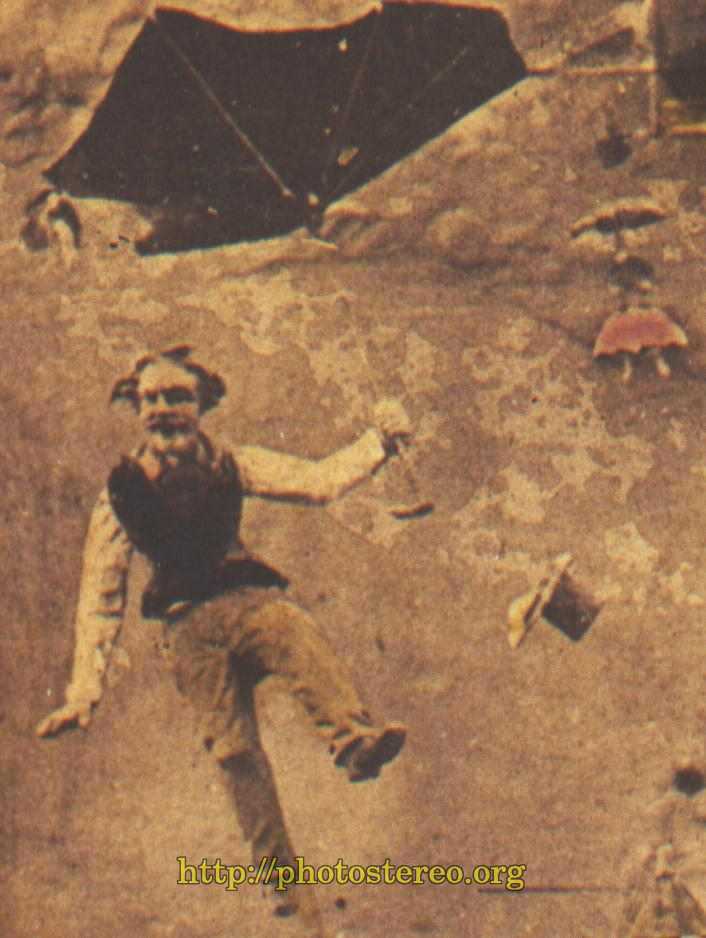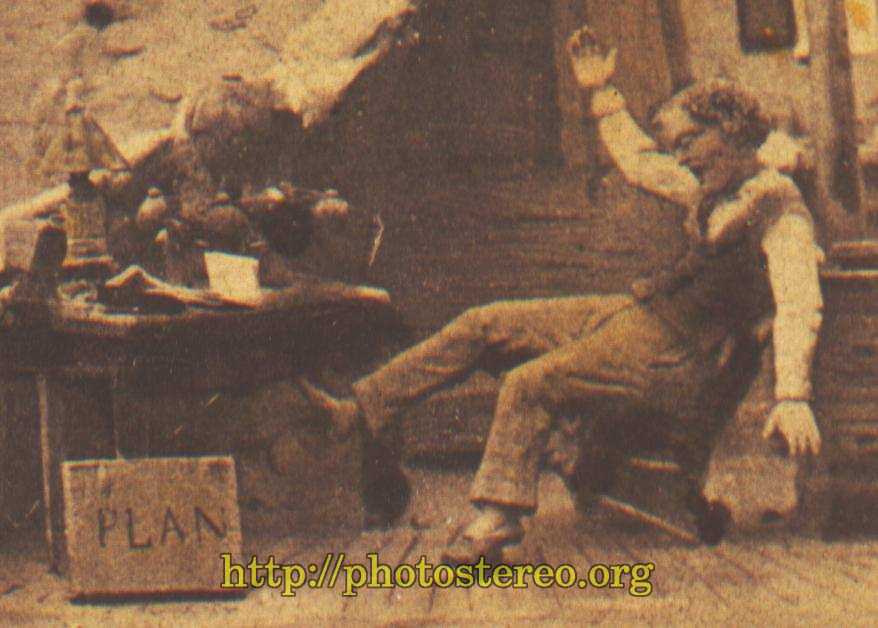Photo: coll_2_141
Songe d'un aéronaute à la recherche du point d'appui.
[ Indexation sur stereotheque.fr ]
Dream of an aeronaut, looking for the support point.
À l'époque de cette photographie, on sait s'élever dans l'air, à l'aide d'un ballon, mais pas se diriger. Le point d'appui s'entend de ce qui permettrait à une force de propulsion de s'exercer.
Au tout début des années 1850, nait l'idée d'ajouter une hélice au ballon, mais sa forme si peu aérodynamique et le volume du moteur rendent les expérimentations peu concluantes.
Sur l'état des lieux en 1841, voir Sanson, A. J., Navigation dans l'air. Le point d'appui aérien applicable à l'aérostation, précédé d'un projet de société aéronautique (...), 1841. Deutches Museum Munchen
https://digital.deutsches-museum.de/item/BV039749276/
Consultation de la version numérisée par Google.
Il commence son propos par «On a essayé mille moyens de diriger les aérostats ; aucun n'a encore réussi.». Tout est dit !
Il faut donc probablement interpréter l'image ainsi : Un inventeur aéronaute s'imagine navigant dans l'air au dessus d'une ville. Il tient dans sa main gauche une sorte de parapluie qui lui permet de maintenir son altitude, alors que ses mouvement lui permettent de se diriger. Son chapeau flotte à ses côtés. À l'arrière plan, d'autres personnages semblent se mouvoir sur le même principe.
En haut à droite de la scène, un promontoire rectangulaire avec des garde-corps tubulaires. Deux ballons aérostatiques y encadrent une locomotive avec la cheminée fumante vers la droite. Il est probable que les personnages s'élancent depuis ce promontoire.
Au pied du personnage en train de rêver, un porte document est adossé au pied avant gauche de sa table de travail. L'inscription "PLAN" sur celui-ci indique qu'il est un inventeur.
La scène est réalisée en pâte à modeler, comme les diableries.
Sur l'exemplaire du musée Paul Getty, une plaquette au premier plan en partie visible sur la vue de gauche, en bas à gauche de celle-ci, inscrite : [Hen]netier (le modeleur Hennetier, qui a participé à nombre de diableries).
Cette vue est particulière par son sujet, mais aussi car on ne peut à ce jour la relier à aucune série.
Un exemplaire en meilleur état au [ Musée Paul Getty, cote 84.XC.870.23 ]
At the time of this photograph, we knew how to rise in the air, using a balloon, but not how to navigate. The support point means what would allow a propulsive force to be exerted.
At the very beginning of the 1850s, the idea of adding a propeller to the balloon was born, but its non-aerodynamic shape and the volume of the engine made the experiments inconclusive.
On the state of affairs in 1841, see Sanson, A. J., Navigation dans l'air. Le point d'appui aérien applicable à l'aérostation, précédé d'un projet de société aéronautique (...), 1841. Deutches Museum Munchen
https://digital.deutsches-museum.de/item/BV039749276/
Consultation of the version digitized by Google.
He begins his remarks with “We have tried a thousand ways of directing the aerostats; none has yet succeeded.” All is said !
We should therefore probably interpret the image as follows: An aeronaut inventor imagines himself sailing in the air above a city. In his left hand he holds a sort of umbrella which allows him to maintain his altitude, while his movements allow him to direct himself. His hat floats at his side. In the background, other characters seem to move on the same principle.
At the top right of the scene, a rectangular promontory with tubular guardrails. Two aerostatic balloons and a steam locomotive with the smoking chimney to the right. It is likely that the characters jump from this promontory.
At the foot of the dreaming character, a document holder leans against the front left leg of his work table. The inscription "PLAN" on it indicates that he is an inventor.
The scene is made of modeling clay, like the Devilries.
On the copy in the Paul Getty Museum, a plaque in the foreground partly visible in the left view, at the bottom left of it, inscribed: [Hen]netier (the modeler Hennetier, who participated in a number of devilries ).
This view is particular because of its subject, but also because it cannot to linked to another series.
A copy in better condition at [ Paul Getty Museum, reference 84.XC.870.23 ]
|
![Songe d'un aéronaute à la recherche du point d'appui.
{%[Indexation sur stereotheque.fr]%https://www.stereotheque.fr/result,15283-22397%} (Dream of an aeronaut, looking for the support point.)](./photos/coll/marques/coll_2_141_66126.jpg)

